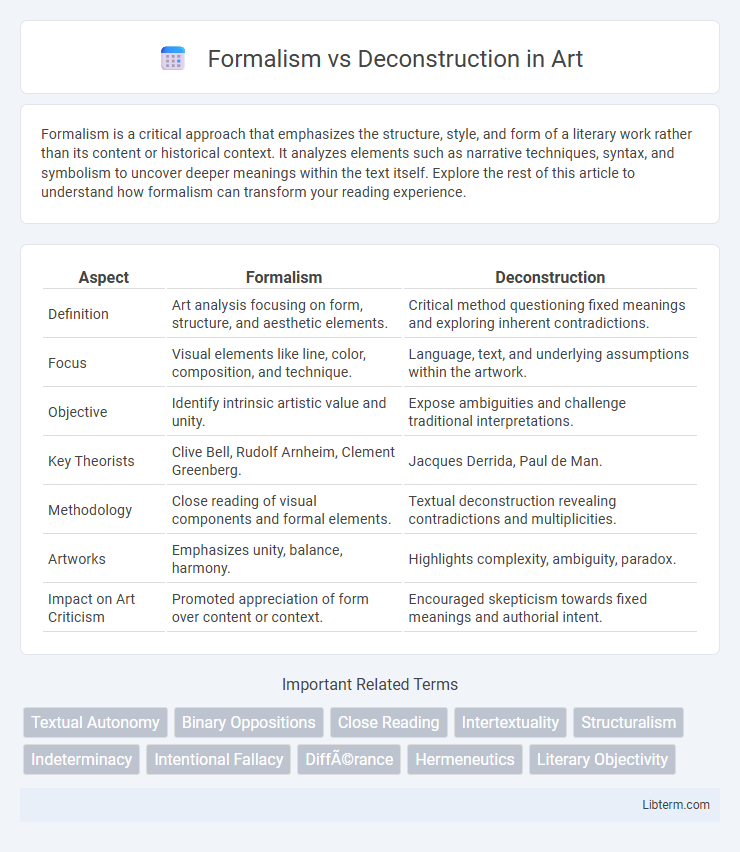Formalism is a critical approach that emphasizes the structure, style, and form of a literary work rather than its content or historical context. It analyzes elements such as narrative techniques, syntax, and symbolism to uncover deeper meanings within the text itself. Explore the rest of this article to understand how formalism can transform your reading experience.
Table of Comparison
| Aspect | Formalism | Deconstruction |
|---|---|---|
| Definition | Art analysis focusing on form, structure, and aesthetic elements. | Critical method questioning fixed meanings and exploring inherent contradictions. |
| Focus | Visual elements like line, color, composition, and technique. | Language, text, and underlying assumptions within the artwork. |
| Objective | Identify intrinsic artistic value and unity. | Expose ambiguities and challenge traditional interpretations. |
| Key Theorists | Clive Bell, Rudolf Arnheim, Clement Greenberg. | Jacques Derrida, Paul de Man. |
| Methodology | Close reading of visual components and formal elements. | Textual deconstruction revealing contradictions and multiplicities. |
| Artworks | Emphasizes unity, balance, harmony. | Highlights complexity, ambiguity, paradox. |
| Impact on Art Criticism | Promoted appreciation of form over content or context. | Encouraged skepticism towards fixed meanings and authorial intent. |
Introduction to Literary Theories
Formalism emphasizes close reading and analysis of a text's structure, language, and literary devices without considering external contexts like author intention or historical background. Deconstruction challenges the idea of fixed meanings by exposing inherent contradictions and ambiguities within the text, revealing multiple interpretations. Both theories contribute significantly to contemporary literary criticism by shifting focus from authorial intent to textual features and reader engagement.
Defining Formalism: Core Principles
Formalism emphasizes the intrinsic features of a literary work, analyzing its structure, language, and style without considering external contexts such as author intent or historical background. Central to Formalism are principles like close reading, the autonomy of the text, and the examination of literary devices, motifs, and narrative techniques that shape meaning. This approach prioritizes form over content, asserting that the text's distinct elements function together to produce its unified artistic effect.
Deconstruction: Origins and Key Ideas
Deconstruction originated in the 1960s with philosopher Jacques Derrida, challenging traditional formalism by exposing the inherent instability of language and meaning. It emphasizes the fluidity of texts, revealing contradictions and multiple interpretations through techniques like "differance" and the critique of binary oppositions. This approach deconstructs the presumed coherence of literary and philosophical works, highlighting the endless play of signifiers that undermine fixed interpretations.
Historical Contexts of Formalism and Deconstruction
Formalism emerged in the early 20th century as a dominant critical approach emphasizing the intrinsic features of literary texts, focusing on structure, style, and language while largely ignoring historical and cultural contexts. Deconstruction arose in the late 1960s as a response to structuralist and formalist methods, highlighting the instability of meaning and the role of power and ideology embedded in language, heavily influenced by post-World War II philosophical shifts and the questioning of traditional authority. The historical contexts of Formalism reflect a modernist desire for scientific objectivity in literary studies, whereas Deconstruction aligns with postmodern skepticism towards grand narratives and fixed interpretations.
Methodologies Compared: How Each Analyzes Text
Formalism analyzes text by focusing on structural elements such as syntax, rhyme, meter, and narrative techniques, emphasizing the text's intrinsic features without external context. Deconstruction critiques the stability of meaning within a text by exposing contradictions, ambiguities, and the fluidity of language, revealing how meanings are constructed and destabilized. While Formalism seeks coherence and unity in the text, Deconstruction interrogates binary oppositions and reveals layers of meaning that undermine singular interpretations.
Formalism: Strengths and Limitations
Formalism emphasizes the intrinsic elements of a text such as structure, style, and literary devices, enabling a detailed analysis that highlights the coherence and unity of a work. Its strength lies in its focus on the text itself, independent of historical or cultural contexts, which allows for an objective interpretation based on form and language. However, Formalism's limitation is its potential neglect of external factors like author intent and socio-political influences, which can lead to an incomplete understanding of a text's broader significance.
Deconstruction: Strengths and Criticisms
Deconstruction, pioneered by Jacques Derrida, reveals inherent contradictions and instability within texts, challenging fixed meanings and encouraging multiple interpretations. Its strength lies in exposing hidden assumptions and power structures embedded in language, making it a vital tool for critiquing traditional hierarchies. Critics argue that deconstruction's emphasis on ambiguity and relativism can lead to excessive skepticism, undermining coherent meaning and practical application in literary analysis.
Major Thinkers and Influential Works
Formalism, championed by Viktor Shklovsky and Roman Jakobson, emphasizes structural elements of texts, with influential works like Shklovsky's "Art as Technique" and Jakobson's essays on poetic language shaping literary analysis. Deconstruction, pioneered by Jacques Derrida, critiques fixed meanings and binary oppositions in language, notably expounded in his seminal work "Of Grammatology." Both schools revolutionized textual interpretation but diverge in focusing on intrinsic literary features versus the instability of language and meaning.
Formalism vs Deconstruction: Case Study Analysis
Formalism emphasizes close reading, structure, and intrinsic elements of a text, analyzing components like plot, characters, and literary devices without external context. Deconstruction challenges fixed meanings in texts, exposing contradictions, ambiguities, and the instability of language to reveal multiple, often conflicting interpretations. A case study comparing Formalism and Deconstruction on Shakespeare's *Hamlet* illustrates Formalism's focus on narrative coherence versus Deconstruction's emphasis on textual instability and the subversion of apparent meanings.
Contemporary Relevance and Future Directions
Formalism emphasizes the intrinsic structures and formal elements of a text, maintaining its relevance in contemporary literary analysis by providing clear methods for interpretation and critique. Deconstruction challenges fixed meanings and binary oppositions, influencing modern critical theory and encouraging ongoing reinterpretations in diverse fields such as cultural studies and philosophy. Future directions highlight a hybrid approach where formalist clarity merges with deconstructive fluidity, fostering nuanced understanding of complex texts in an increasingly interdisciplinary academic landscape.
Formalism Infographic

 libterm.com
libterm.com